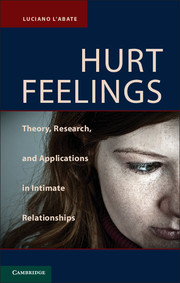Book contents
- Frontmatter
- Contents
- Preface
- Acknowledgments
- Introduction
- Part One Background
- Part Two The Scientific Bases of Hurt Feelings
- Part Three Applications of Hurt Feelings in Mental Health
- 11 Sharing Hurt Feelings in Social-Support
- 12 Psychotherapy
- Part Four Models of Hurt Feelings In Theory and Applications
- Appendix A An Informed Consent Form to Deal with Hurt Feelings
- Appendix B Experimental Scale of Unexpressed Hurt Feelings
- References
- Author Index
- Subject Index
12 - Psychotherapy
Sharing Hurt Feelings and Fears of Being Hurt
from Part Three - Applications of Hurt Feelings in Mental Health
Published online by Cambridge University Press: 05 June 2012
- Frontmatter
- Contents
- Preface
- Acknowledgments
- Introduction
- Part One Background
- Part Two The Scientific Bases of Hurt Feelings
- Part Three Applications of Hurt Feelings in Mental Health
- 11 Sharing Hurt Feelings in Social-Support
- 12 Psychotherapy
- Part Four Models of Hurt Feelings In Theory and Applications
- Appendix A An Informed Consent Form to Deal with Hurt Feelings
- Appendix B Experimental Scale of Unexpressed Hurt Feelings
- References
- Author Index
- Subject Index
Summary
The idea that accessing and exploring painful emotions and “bad feelings” in a therapeutic relationship makes one feel better is a widely held belief among several schools of psychotherapy.
Greenberg & Pascal-Leone (2006, p. 611)
The purpose of this chapter is to consider how the professional community has dealt with hurt feelings in face-to-face (F2F) talk-based (TB) contacts between psychotherapists and their participants. First, the avoidance of hurt feelings in the professional literature will be reviewed. Second, instead of reviewing and therefore duplicating unstructured, old, tried but not always true, traditionally expensive F2F, TB approaches that continue to dominate the field of psychotherapy, the specific contributions of Susan M. Johnson and Leslie S. Greenberg will be reviewed; their work amounts to a sea change with regard to its inclusion of feelings and emotions in psychotherapy processes and outcomes. This approach is in contrast, if not in opposition to, the behavioral-cognitive school that makes thinking responsible for how we feel. The field of psychotherapy has been dominated heretofore by the behavioral-cognitive school, which does not emphasize the importance of feelings in general and of hurt feelings in particular. Feelings are the product of how we think rather than the other way around. Against such hegemony, for the past twenty years Greenberg and Johnson (1990) have emphasized the importance of feelings and emotions. Hurt feelings are predominant although not addressed specifically by either therapist. Third, research on distance writing (DW) will be reviewed. Fourth, issues of psychotherapy with complex and very likely resistant cases of persistent grief will be reviewed. Fifth, one indirect and one direct prescription relating to hurt feelings will be presented.
Avoidance of Hurt Feelings in The Professional Literature
There is plenty of literature showing that the topic of hurt feelings has been avoided consistently in the psychotherapy community, even though these feelings lie at the bottom of a great deal of dysfunctionality and psychopathology, that is, the “unconscious” as discussed in previous chapters of this volume. A few representative examples from relevant professional texts will be included to support the avoidance of or inconsistent reliance on a variety of different feelings, which relies on an explanatory construct to deal with maladaptive behaviors. In an early treatise, Nichols and Zax (1977) included anger, anxiety, depression, and a Discomfort Relief Quotient (p. 177). These authors, like many others to follow, included the term distress throughout the text without defining it. However, the term was not included in the subject index. Pierce, Nichols, and DuBrin (1983) included “recall of repressed material” (p. 4) and “repressed affects” (pp. 5, 30). However, the only affect they included was “embarrassment” (p. 189). Safran and Greenberg (1991) considered at great length affects and emotions including anger, anxiety, depression, embarrassment, fear, and sadness, but neither distress nor hurt feelings were included. Johnson (2002) considered anger, anxiety, depression, and fear, but did not include either distress or hurt feelings, as if these feelings did not exist in trauma survivors.
- Type
- Chapter
- Information
- Hurt FeelingsTheory, Research, and Applications in Intimate Relationships, pp. 273 - 294Publisher: Cambridge University PressPrint publication year: 2011



